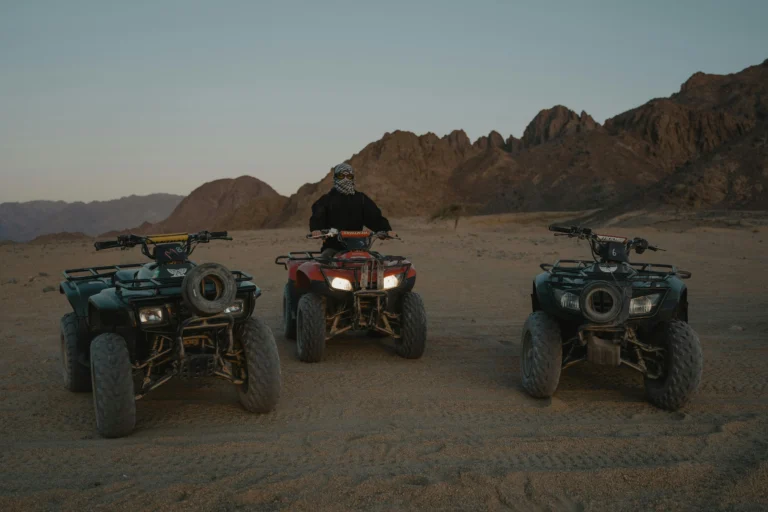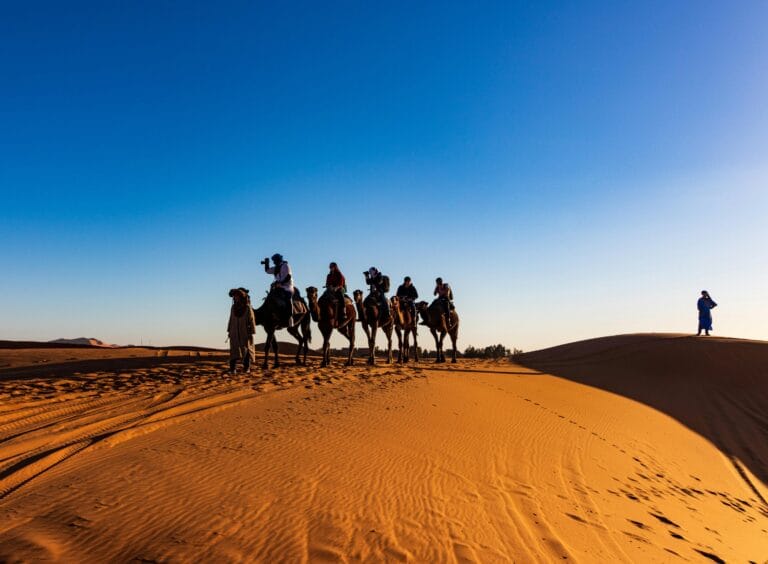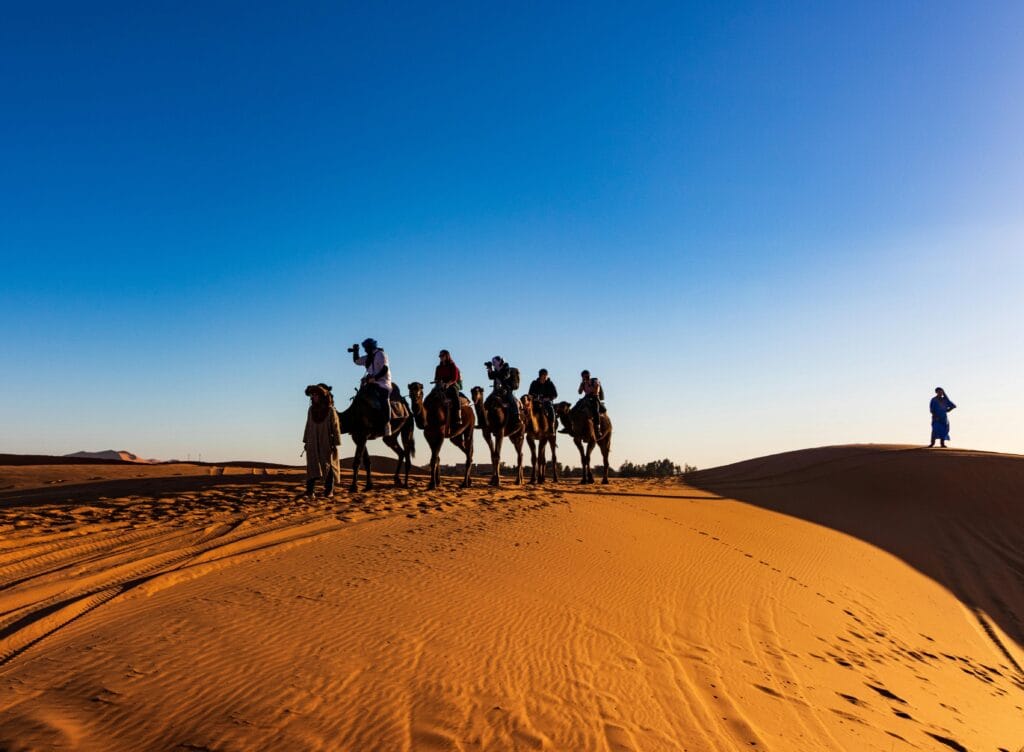
sahara desert
The Sahara Desert is the largest hot desert in the world, covering almost all of North Africa and stretching over 9 million square kilometers. This massive space is full of sand dunes, rocky plateaus, and even a few mountains. The Sahara is so big that it takes up about a third of the whole African continent.
You might imagine the Sahara as nothing but endless sand, but there is a lot more to it. The desert has unique animal and plant life, beautiful landscapes, and a rich history that includes ancient trade routes. If you want to learn some surprising facts about the Sahara, including its size, location, and what makes it different from other deserts, keep reading to find out more about the world’s most famous desert.
It’s hard to picture the true size and beauty of the Sahara Desert until you look closer.
Table of Contents
Geography and Location
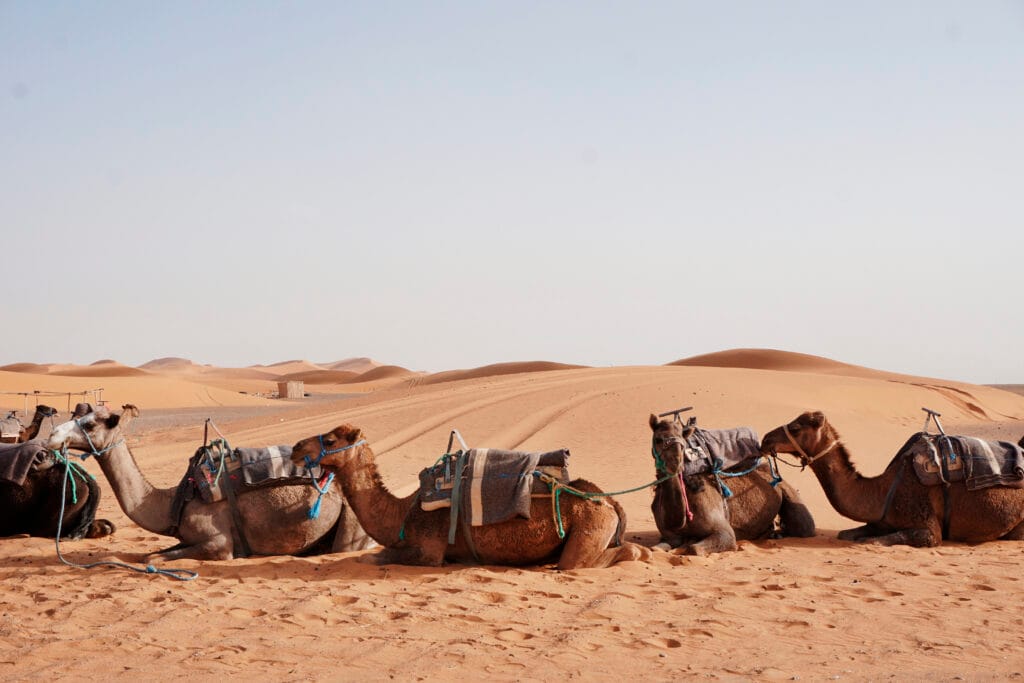
The Sahara is the world’s largest hot desert and covers much of northern Africa. You will find a mix of vast sand dunes, rocky plateaus, and rugged mountains here. Arid conditions, extreme temperatures, and unique landforms define its landscape.
Boundaries and Area
The Sahara stretches across North Africa. It reaches from the Atlantic Ocean in the west all the way to the Red Sea in the east. To the north, it touches the Mediterranean Sea, and to the south, you will find the Sahel savanna. These natural borders give the desert a massive presence on the African continent.
This desert covers an area of about 9,200,000 square kilometers (around 3.6 million square miles). That means the Sahara is almost as large as the United States or China. It fills close to a third of all Africa, making it the largest hot desert on Earth. Only some cold deserts like Antarctica are bigger.
Countries and Regions
When you look at a map, you can see that the Sahara spans eleven countries. These countries include Morocco, Algeria, Tunisia, Libya, Egypt, Mauritania, Mali, Niger, Chad, Sudan, and Western Sahara.
Many of these countries share broad stretches of desert sand and rocky plains. For example, much of Algeria, Libya, and Egypt falls within the Sahara’s boundaries. You’ll also find important regions such as the Libyan Desert and the Western Desert of Egypt, showing how the Sahara is divided into smaller regional names within each country. Some areas, like the Qattara Depression in Egypt, dip below sea level.
Notable Features
The Sahara isn’t just miles of sand. Its landforms include massive sand dunes, rocky plateaus, dry basins, and even volcanic peaks. Ergs, or “sand seas,” are wide areas of shifting dunes. Rocky tablelands called hammadas are also common.
Mountain ranges like the Atlas Mountains in the northwest and the Tibesti Mountains in Chad and Libya add dramatic height to the desert landscape. The highest point in the Sahara is Emi Koussi, a volcanic peak in the Tibesti Mountains. You will also find deep depressions, like Qattara Depression, which is among the lowest points in Africa.
Climate and Weather

The Sahara Desert experiences some of the hottest and driest conditions on Earth. You will notice huge changes in temperature, very little rain, strong winds, and signs of climate change that affect the landscape.
Temperature and Rainfall
Temperatures in the Sahara often climb above 40°C (104°F) during the summer and can even reach up to 47°C (116.6°F) in some regions. At night, it gets much cooler, sometimes dropping near freezing in winter. This big difference between day and night temperatures is called the diurnal range.
Rain is very rare. On average, the Sahara receives less than 25 mm (one inch) of rainfall each year. Large areas stay dry for months or even years. When rain does fall, it is usually short, heavy, and can lead to quick floods due to the hard, dry ground.
These dry and arid conditions make it hard for moisture to stay in the soil. Most plants and animals need special adaptations just to survive.
Winds and Dust Storms
The Sahara is well known for its strong winds. Hot, dry air moves across the sand, picking up dust and carrying it for hundreds or even thousands of miles. These winds mostly come from the east and often create powerful dust storms, known as haboobs.
Dust storms can block out sunlight, lower visibility, and make travel dangerous. The sand and dust even travel across oceans to places like South America and the Caribbean.
Wind in the Sahara shapes sand dunes and erodes high landforms. Sometimes, the winds can bring short bursts of rain during rare monsoon periods at the southern edges, closer to savanna regions.
Climate Change Impact
Climate change is beginning to affect the Sahara in noticeable ways. Over the past century, the desert has been growing, with savanna grasslands shrinking in some areas. Some scientists believe the Sahara was once much greener, a time known as the Green Sahara, when more rain fell and large lakes existed.
Today, rising temperatures and changing weather patterns may cause even less precipitation and make arid conditions worse. There is less moisture in the air, and droughts have become more common. This impacts people, plants, and animals that depend on rain and seasonal rivers.
Climate change can also influence wind patterns, possibly leading to more severe dust storms in the future.
Landscapes and Natural Features
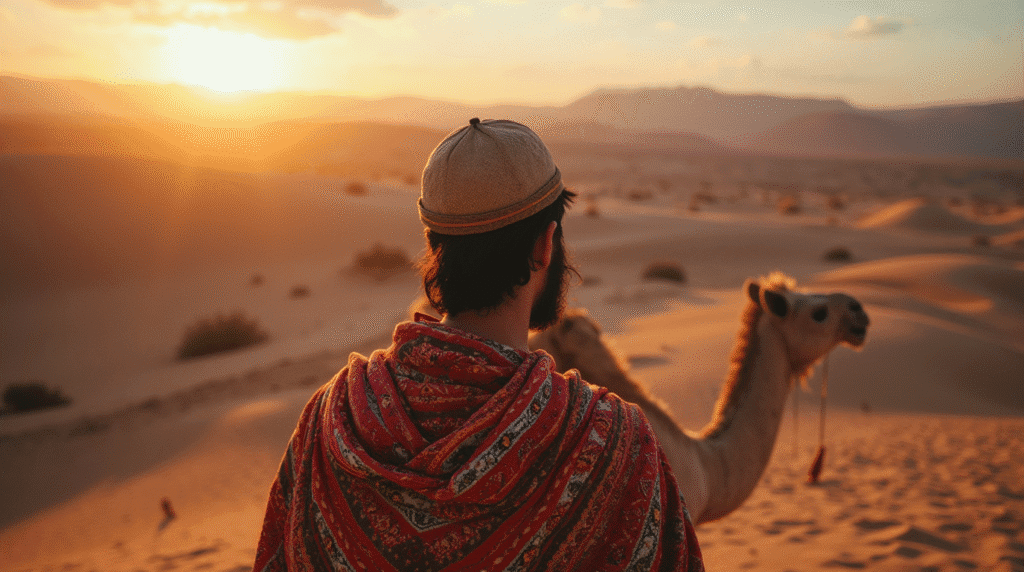
You’ll find the Sahara isn’t just endless sand. Its terrain changes from huge seas of dunes to spots with water, and even dry, flat salt areas.
Ergs and Dune Fields
Ergs, also called “sand seas,” are wide areas filled with sand dunes. These cover about 20% of the Sahara. Most ergs are shaped by strong winds, which move sand and build dunes as high as a 10-story building. The Grand Erg Oriental and Grand Erg Occidental in Algeria are among the largest.
Dune shapes include crescent (barchan), star, and linear dunes. Each type forms based on wind direction and strength. Some dunes shift and change shape over weeks or months. Walking across a dune field means you’ll see patterns and small ridges, made by the wind.
Not all of the Sahara is made of sand dunes, though. You’ll also spot rocky areas called hamada, and gravel plains. Read more about Sahara’s dune fields and landscapes.
Oases and Water Sources
Oases are pockets of green where plants and people can thrive. These areas form where underground water from aquifers or rare rains reach the surface. Water makes life possible for date palms, crops, and towns. Some famous oases sit near the Nile and Niger River.
Aquifers under the Sahara store ancient water, and deep wells let people reach it. Rain is rare, but when it falls, it can bring temporary lakes and extra moisture. Animals and people use these areas for rest and resources.
Many travelers and traders have relied on oases for centuries. You’ll often see palm trees, small farms, and mud-brick homes in these green spots.
Salt Flats and Depressions
Salt flats, also called sebkhas or chotts, are wide, flat areas left behind when lakes or shallow seas dry up. Sun and wind pull the water away, leaving crusts of salt and minerals. These flats can be crusty and white, and may stretch for miles.
Depressions are low places under sea level. The Qattara Depression in Egypt is one of the largest, dropping about 133 meters below sea level. Some depressions flood for a short time in rainy years, creating seasonal lakes.
You’ll often find salt crusts, cracked earth, and almost no plants in these spots. Local people sometimes collect salt here and sell it in nearby markets. Salt flats and depressions help shape the harsh but unique environment of the Sahara.
Flora and Fauna
The Sahara Desert might look empty, but it supports many kinds of life. You can find special plants and unique animals that have adapted to survive in this harsh environment.
Plants and Vegetation
You will notice that the plants in the Sahara are spread far apart. The harsh heat and lack of water mean only certain types of vegetation can grow.
Most of the time, you’ll see scattered shrubs, tough grasses, and a few trees, especially in areas with a little more water, like oasis spots or dry riverbeds called wadis. Common plants include acacia trees, date palms, and tamarisks. These plants often have small waxy leaves or thorns to help save water and handle extreme heat.
Much of the land is bare sand or rock, but places with underground water allow some limited agriculture. Here, people can grow crops like dates, barley, and wheat. Even in the driest parts, some algae can be found in seasonal pools.
For a closer look at the different kinds of Saharan vegetation, check out this resource.
Desert Animals
Animals of the Sahara are just as impressive as its plants. You may see animals big and small, each with ways to deal with the desert’s heat and dry air.
Large mammals include the addax antelope, dama gazelles, and other types of antelope that travel long distances for food and water. Camels are common and known for storing fat in their humps, helping them go days without water. The few remaining crocodiles live in isolated ponds.
You’ll also find reptiles like lizards, skinks, and cobras. Insects such as ants, beetles, and locusts are common, especially near plants. Birds such as sandgrouse and larks can be seen searching for food or water.
To learn more about the wildlife of the Sahara, you can explore this link.
Human Habitation and Culture
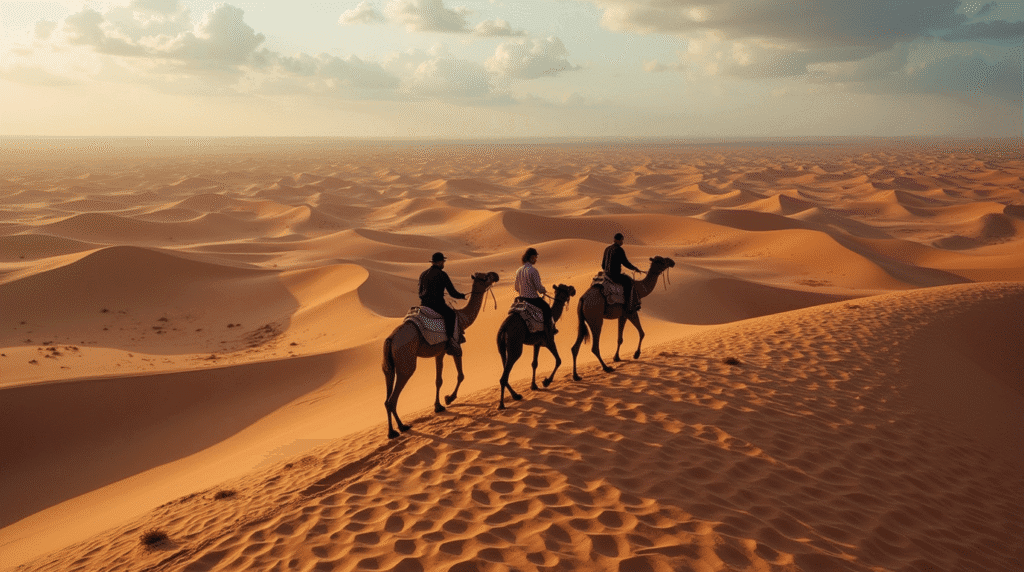
Across the Sahara Desert, people have learned to adapt to harsh, arid conditions. From ancient trade cities to diverse languages, human life here shows resilience, creativity, and close ties to the land.
Indigenous Peoples and Languages
You will notice the Sahara is home to several Indigenous groups. The most well-known are the Berber and Tuareg peoples. These groups have lived in the desert for centuries, building strong communities and rich traditions.
People speak languages like Berber, Arabic, and Tamasheq, the language of the Tuareg. Arabic spread widely after early Islamic expansion, but Berber languages remain important, linking families and local tribes.
Cultural features include:
- Oral storytelling passed down through generations
- Colorful clothing designed to block sun and sand
- Music and poetry celebrating desert life
Many people in the Sahara are nomadic, moving with their herds. Others live in oasis towns or practice farming where water is available.
Historic Settlements and Cities
Cities like Timbuktu and Agadez became famous as centers of learning and trade. Timbuktu, located along ancient caravan routes, was once known for its libraries and scholars in science and religion.
In the Nile Valley, societies practiced agriculture using the river’s water. This allowed them to grow wheat, barley, and other crops, even in an inhospitable climate.
Oases were lifelines for desert travelers. Towns grew around these fertile spots, offering places to rest, trade, and share knowledge. Ghardaia and other oasis towns still show unique architecture and community planning suited for extreme heat.
Table: Historic Desert Cities
| City | Region | Known For |
|---|---|---|
| Timbuktu | Mali | Learning, trade, manuscripts |
| Agadez | Niger | Caravan trade, cultural festivals |
| Ghardaia | Algeria | Oasis life, unique architecture |
Modern Life and Challenges
Today, many people still herd camels, goats, and sheep, while others farm near oases. Urban areas have grown, but life remains shaped by the desert’s tough environment.
You might find mix of new and old—solar panels alongside traditional tents. Access to fresh water is a big challenge, especially as some oases shrink.
Common modern issues:
- Scarcity of water resources
- Desertification making land less usable
- Migration away from villages to cities
As more people use mobile phones and satellite internet, young people learn about the wider world, yet many traditional beliefs and crafts remain alive. In some places, scientists study how people adapt to the arid conditions that have shaped life for thousands of years.
At Explore Morocco, our mission goes beyond sharing information — we’re here to guide you, inspire you, and help you plan unforgettable experiences in Morocco. Whether you’re dreaming of vibrant souks, peaceful desert nights, or hidden gems only locals know, consider us your trusted companion. We offer free advice, personalized tips, and we’re always ready to assist you with any service you might need during your journey. Your perfect Moroccan adventure starts here, and we’re excited to be part of it!


